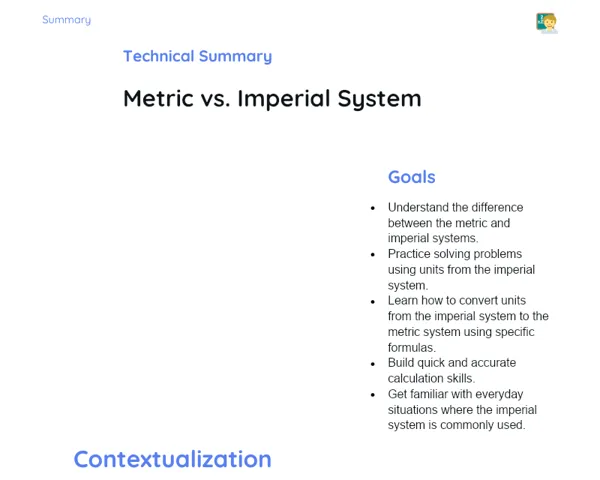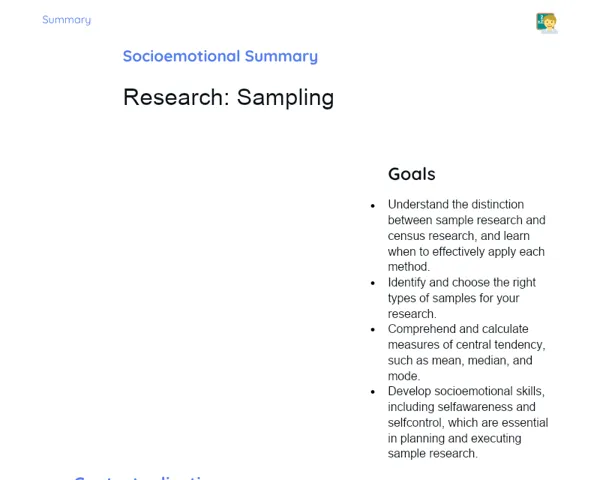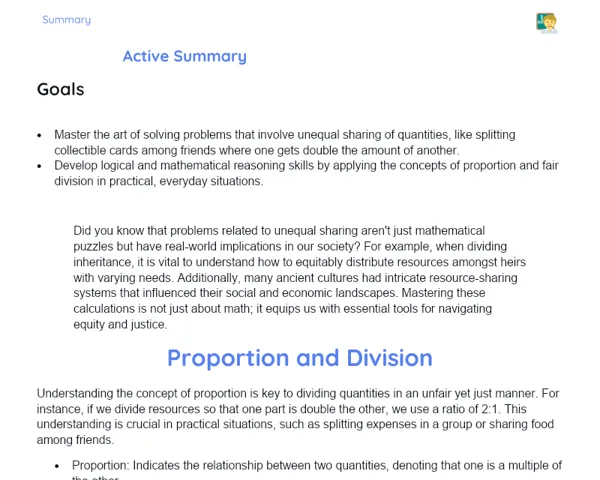Summary Tradisional | Spatial Geometry: Cavalieri's Principle
Contextualization
Spatial Geometry is an important branch of Mathematics that deals with three-dimensional shapes and their properties. Within this field, Cavalieri's Principle serves as a key tool for comparing the volumes of different solids. Named after the Italian mathematician Bonaventura Cavalieri, the principle states that if two solids have the same height and their cross-sectional areas at every level are equal, then their volumes are also equal. This approach offers a more intuitive and visual way to understand volumes, rather than relying purely on complex formulas.
Cavalieri's Principle finds application in several areas such as engineering, architecture, and medicine. For example, in the medical field, it plays a crucial role in assessing volumes in MRI and CT scans. Similarly, in engineering and architecture, it is used to calculate the volumes of intricate structures, which aids in the planning and construction of buildings. Grasping and applying Cavalieri's Principle not only helps in academic studies but also enhances practical problem-solving skills in real-world scenarios.
To Remember!
Introduction to Cavalieri's Principle
Cavalieri's Principle is a mathematical concept that enables us to compare the volumes of three-dimensional objects in a very visual and straightforward manner. According to this principle, if two solids have the same height and the areas of their cross-sections at every level are identical, then their volumes must also be the same.
This idea is a tribute to the Italian mathematician Bonaventura Cavalieri, who introduced it in the 17th century. He is considered one of the early contributors to the development of integral calculus. The principle offers an alternative perspective to understand volumes, especially when traditional formulas seem too complicated or impractical for irregular shapes.
Thus, Cavalieri's Principle is not only a powerful theoretical tool but also extremely useful when dealing with complex irregular forms in practical situations.
-
Cavalieri's Principle helps in comparing volumes of three-dimensional objects.
-
It asserts that if cross-sectional areas at every level are the same, the volumes are equal.
-
Named after Bonaventura Cavalieri, a notable Italian mathematician.
Visual Demonstration of the Principle
One of the best ways to comprehend Cavalieri's Principle is by using visual demonstrations. By employing three-dimensional models or sketches, one can clearly show how the principle works in practice. For instance, consider two cylinders with the same height and base area. Even if one cylinder appears flatter and the other more elongated, they will have identical volumes provided the cross-sectional areas measured at any level are the same.
Another practical example could involve a rectangular prism and a circular cylinder. If both have the same height and their cross-sectional areas at any height are equal, then by Cavalieri's Principle, their volumes are also equal.
Such visual examples are invaluable, as they offer a tangible understanding of how the principle is applied to compare the volumes of different solids.
-
Visual methods greatly aid in understanding Cavalieri's Principle.
-
Example: two cylinders with equal heights and base areas yield equal volumes.
-
Similarly, prisms and cylinders with the same height and identical cross-sectional areas have equal volumes.
Practical Applications of Cavalieri's Principle
Cavalieri's Principle is far from being just a theoretical idea; it has various practical uses in disciplines like engineering, architecture, and medicine. Civil engineers and architects, for example, often use this principle to estimate the volumes of complex construction elements, thereby contributing to more efficient and accurate designs.
In the field of medicine, this principle assists in analysing the volumes of organs and tissues using MRI and CT scans. By taking cross-sectional images, doctors are able to calculate the overall volume of an organ, which is critical for diagnosis and treatment planning.
These examples illustrate the wide-ranging significance of Cavalieri's Principle, proving its value beyond the classroom mathematically and into real-life problem solving.
-
Used in engineering and architecture for estimating volumes of complex structures.
-
Helps in medical analysis by assessing volumes in MRI and CT scans.
-
Assists in achieving precise and efficient designs and diagnostics.
Comparing Volumes Using Cavalieri's Principle
Cavalieri's Principle makes it simpler to compare volumes of different geometric figures. The rule is that if two solids have the same height and identical cross-sectional areas at every level, then they must have the same volume. Essentially, the task of comparing volumes gets reduced to verifying these specific conditions.
For example, if we compare a cylinder and a rectangular prism with equal heights, and if at every level their cross sections are of equal area, their volumes will turn out to be identical. This method can be clearly demonstrated, thus enhancing our understanding of the concept.
In summary, using Cavalieri's Principle is an effective and powerful technique to analyse and compare volumes of complex shapes in Spatial Geometry.
-
Verify if the conditions of the principle hold to compare volumes.
-
Example: a cylinder versus a rectangular prism with equal heights and cross-sectional areas.
-
An effective strategy for analysing volumes of intricate solids.
Key Terms
-
Spatial Geometry: A branch of mathematics that focuses on understanding three-dimensional shapes.
-
Cavalieri's Principle: A method of comparing volumes of solids with identical heights and equal cross-sectional areas.
-
Cross Section: The intersection of a solid with a plane, resulting in a two-dimensional shape.
-
Volume: A measurement of the space occupied by a three-dimensional object.
Important Conclusions
In today’s lecture, we delved into Cavalieri's Principle, which is a vital tool in Spatial Geometry for comparing the volumes of three-dimensional solids. Through several visual demonstrations and practical examples, we learned that if two solids have the same height and equal cross-sectional areas at each level, then their volumes are also the same. This method offers an intuitive and visual approach to understanding volumes rather than solely relying on traditional formulas.
We also examined real-world applications of this principle in fields like engineering, architecture, and medicine. For instance, in construction, it helps calculate the volumes of complex structures, making it easier to design and build efficiently. Similarly, in healthcare, it is used to measure volumes in MRI and CT scans, which is vital for accurate diagnosis and treatment.
A sound understanding of Cavalieri's Principle not only strengthens your grasp of spatial geometry but also equips you with practical problem-solving skills applicable in various professional fields. I encourage you to continue exploring this principle and its applications to further enhance your understanding and proficiency in the subject.
Study Tips
-
Revisit the lecture notes and visual demonstrations to consolidate your understanding of Cavalieri's Principle.
-
Practice solving problems by comparing volumes using different geometric shapes.
-
Explore additional real-life applications of Cavalieri's Principle in areas like engineering and medicine to appreciate its practical value.



